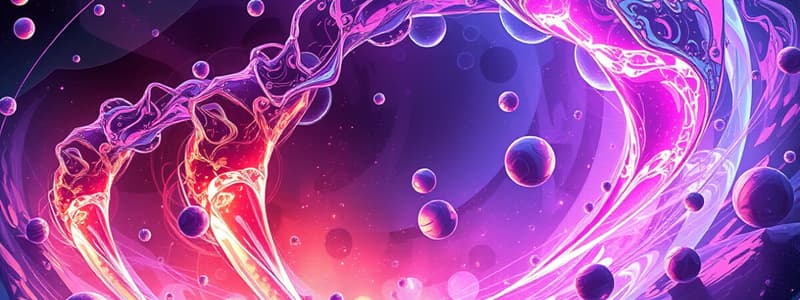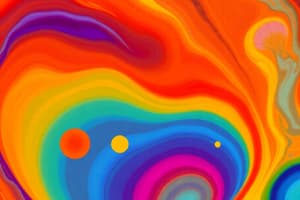Podcast
Questions and Answers
How many grams of KNO3 will make a saturated solution at 50°C?
How many grams of KNO3 will make a saturated solution at 50°C?
83 grams
If you had 100 g of KNO3 at 30 degrees, what type of solution will you have?
If you had 100 g of KNO3 at 30 degrees, what type of solution will you have?
Super saturated
How much NaCl can be dissolved in 300 grams of water at 90°C?
How much NaCl can be dissolved in 300 grams of water at 90°C?
120 g
If you have 80 grams of NaCl in 100 g of water at 90°C, what type of solution do you have?
If you have 80 grams of NaCl in 100 g of water at 90°C, what type of solution do you have?
Which substance is most soluble at 10°C?
Which substance is most soluble at 10°C?
Which substance is least soluble at 10°C?
Which substance is least soluble at 10°C?
How much SO2 can be dissolved in 100 g of water at 10°C?
How much SO2 can be dissolved in 100 g of water at 10°C?
Which substance shows the greatest variation with temperature?
Which substance shows the greatest variation with temperature?
Which substance shows the least change in temperature?
Which substance shows the least change in temperature?
If you have 50 g of NaNO3 in 100 g of water at 10°C, how many more grams will you need to add for the solution to be saturated?
If you have 50 g of NaNO3 in 100 g of water at 10°C, how many more grams will you need to add for the solution to be saturated?
Temperature or pressure's impact on solubility is shown on what?
Temperature or pressure's impact on solubility is shown on what?
What is a solution that holds as much solute in it as possible at a given temperature called?
What is a solution that holds as much solute in it as possible at a given temperature called?
What is a solution that doesn't hold as much solute as possible at a given temperature called?
What is a solution that doesn't hold as much solute as possible at a given temperature called?
What is a solution that holds more solute than predicted at a given temperature called?
What is a solution that holds more solute than predicted at a given temperature called?
What is the part of a solution that does the dissolving?
What is the part of a solution that does the dissolving?
What is the part of a solution that gets dissolved?
What is the part of a solution that gets dissolved?
What is known as the universal solvent?
What is known as the universal solvent?
What describes a homogeneous mixture?
What describes a homogeneous mixture?
What describes a heterogeneous mixture?
What describes a heterogeneous mixture?
Flashcards are hidden until you start studying
Study Notes
Solubility Curves Overview
- Solubility curves illustrate the relationship between temperature and the amount of solute that will dissolve in a solvent.
- KNO3 has a notable solubility increase with temperature changes.
Saturated, Unsaturated, and Supersaturated Solutions
- A saturated solution holds the maximum amount of solute at a specific temperature; observed when some solute remains at the bottom.
- An unsaturated solution contains less solute than could potentially dissolve at that temperature; no solute settled at the bottom.
- A supersaturated solution contains more solute than the predicted saturation level; often formed by cooling a saturated solution without crystallization.
Key Solubility Data
- At 50°C, 83 grams of KNO3 will create a saturated solution.
- 100 grams of KNO3 at 30°C results in a supersaturated solution.
- 300 grams of water can dissolve 120 grams of NaCl at 90°C.
- 80 grams of NaCl in 100 grams of water at 90°C indicates a supersaturated condition.
- 17 grams of SO2 can dissolve in 100 grams of water at 10°C.
Solubility Characteristics of Different Substances
- KI is the most soluble substance at 10°C.
- KClO3 is the least soluble at 10°C.
- KNO3 exhibits the greatest variation in solubility with temperature changes.
- NaCl shows the least change in solubility with varying temperature.
Grams Needed for Saturation
- To saturate a solution at 10°C with 50 grams of NaNO3 already present, an additional 30 grams is needed.
Definitions of Solution Types
- A saturated solution is one that holds as much solute as possible.
- An unsaturated solution has not reached its solubility limit.
- A supersaturated solution holds more solute than the predicted saturation for that temperature.
Mixture Types
- Homogeneous mixtures have the same composition throughout.
- Heterogeneous mixtures differ in composition throughout.
Solvent and Solute
- The solvent is the component of a solution that dissolves the solute.
- The solute is the substance that dissolves within the solvent.
Universal Solvent
- Water is referred to as the universal solvent due to its ability to dissolve many substances.
Other Important Definitions
- Concentrated solutions contain a high amount of solute.
- Solubility curves graphically represent solute dissolution in water across various temperatures.
- Solubility of solids and liquids typically increases with temperature, while gas solubility tends to decrease as temperature rises.
Studying That Suits You
Use AI to generate personalized quizzes and flashcards to suit your learning preferences.




